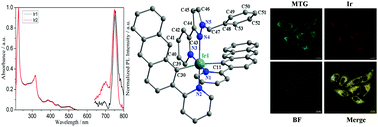Near-infrared emitting iridium(iii) complexes for mitochondrial imaging in living cells†
Abstract
Biocompatible transition metal complexes dyes emitting in the near-infrared (NIR) region, are highly desirable in fluorescence imaging techniques. However, a high-performance mitochondria-specific labeling NIR probe with high photostability is still lacking. Herein we reported two NIR-emitting cationic iridium(III) complexes [Ir(pbq-g)2(N^N)]+Cl− (pbq-g = phenylbenzo[g]-quinoline; N^N = 2-(1-benzyl-1H-pyrazol-3-yl) pyridine (Ir1) and 2-(1-(naphthalen-1-ylmethyl)-1H-pyrazol-3-yl) pyridine (Ir2)). These two novel Ir(III) complexes with different N^N ligands exhibited similar NIR emission with λmax at 751 nm for Ir1 and 750 nm for Ir2 in PBS solution, with luminescence quantum yields of around 0.62 for Ir1 and 0.85 for Ir2. These two complexes showed high mitochondrial specificity, superior photostability, high resistance to the loss of the mitochondrial membrane potential and appreciable tolerance to environmental changes, allowing NIR imaging of mitochondrial morphological changes over long periods of time. These excellent photophysical and imaging properties made them promising NIR luminescent tags for applications in bioimaging.



 Please wait while we load your content...
Please wait while we load your content...